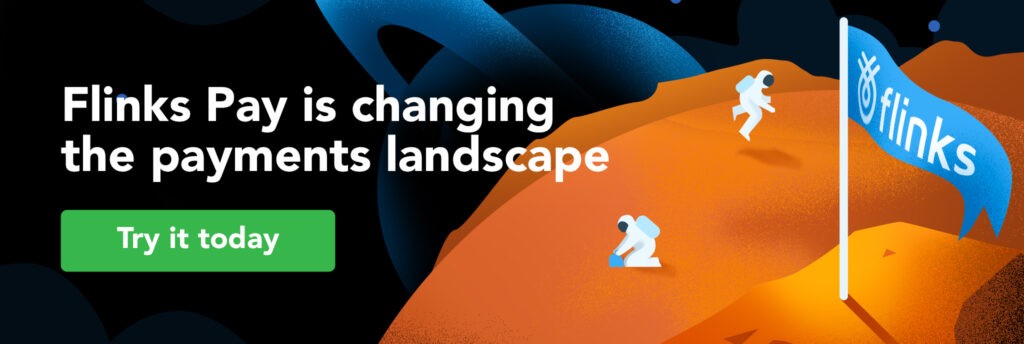
Flinks gives you the power to build the future of finance. Connect, enrich and utilize financial data to delight your customers with amazing products.
EFTs in Canada – The Table Stakes of the Cashless Economy
In Canada’s evolving financial landscape, the convenience and efficiency of digital transactions are seeing a cashless economy swiftly taking shape, with Electronic Funds Transfers (EFTs) as the cornerstone of these digital transactions. EFTs accounted for 59% of total payment value compared to all other payment types in 2022, in comparison to 47% in 2017. This shift is partly driven by the desire for frictionless payments and the growing consumer preference for digital wallets and non-face-to-face payments.
EFTs encompass a wide array of financial operations, all of which offer a secure and labour-saving alternative to traditional cash or cheque-based methods. They enable businesses and individuals to conduct digital transactions with ease. Let’s take a closer look at EFTs and get a glimpse into Canada’s payments landscape.
What are EFTs?
EFTs are a key component of the cashless economy. Essentially, they are a method of providing the electronic exchange of money from one bank account to another, across different banks, enabling the movement of money digitally. This encompasses a variety of cashless transactions such as direct deposits and transfers initiated via online banking.
EFTs offer a secure, efficient, and convenient method for conducting digital transactions, reducing the need for physical cash and facilitating a more streamlined and accessible way of managing payments.
Why are EFTs the standard for payments today?
The role of mobile payment platforms: As mobile payment platforms rise in popularity, they often rely on the robust infrastructure of EFTs to ensure seamless and secure money movement. EFTs provide the backbone for these innovative platforms, enabling relatively frictionless, reliable digital transactions that users can trust for their financial needs.
The integration of EFT capabilities within financial solutions: By embedding EFT functionality into solutions such as loan management systems (LMS) and digital banks, EFTs are transforming how individuals and businesses handle their finances, offering efficient and automated payment processes. These solutions provide users with a seamless way to initiate transactions directly within their platform, enhancing efficiency and accuracy. This also empowers users with a more cohesive and controlled approach to managing their monetary flows.
The discovery of new use cases: EFTs are introducing swift, convenient, and secure transactions that support a wide range of new services. This includes advanced payments for gig economy workers, hassle-free automated bill payments and secure account funding payment flows. Credit rebuilding programs are another example, with EFTs facilitating payment programs that make it easy for users to build back their credit without the need of manual intervention.

Common types of EFTs
Pre-authorized debit (PAD): A form of EFT where customers authorize the automatic withdrawal of funds from their bank account for recurring payments or subscriptions. This ensures hassle-free transactions by eliminating the need for manual payment submissions, providing a convenient and reliable method for managing regular financial commitments.
Wire transfers: A high-speed, high-cost, secured EFT method used for sending large sums of money domestically or internationally. Funds are often moved between financial institutions, typically on the same day, providing a secure and efficient way to transfer significant amounts for time-sensitive transactions.
Direct deposits: This type of EFT is when funds are electronically transferred directly into a recipient’s bank account. Direct deposits are commonly used for payroll, benefits, tax refunds, and other types of payments, offering a secure, efficient, and reliable method for depositing funds without the need for physical cheques.
Top use cases for EFTs
| Bill Payments | For individuals and businesses, EFTs are commonly used to pay bills online directly from a bank account, eliminating the need for cheques or cash. |
| Loan Payments | EFTs enable simplification of the loan repayment process by offering a secure, swift, and automated means to transfer funds, ensuring timely payments and reducing the administrative burden for both borrowers and lenders. |
| Direct Deposit | Employers often use EFTs to deposit wages directly into employees’ bank accounts, making the payment process more efficient. |
| Online Shopping | EFTs can sometimes be used for online purchases (although this is rare), allowing consumers to pay directly from their bank accounts for larger or recurring purchases. |
| Buy-Now-Pay-Later (BNPL) | Enhances the BNPL experience by enabling smooth, automated repayments, which align with customers’ financial cycles and bolster timely collections for merchants. |
| Earned Wage Access (EWA) | Allows employees to access their earned but unpaid wages before the regular payday, providing financial flexibility and reducing the need for high-interest loans or credit card debt – often processed via EFT. |
| Money Transfers | EFTs enable quick and easy money transfers between different bank accounts, both domestically and internationally. |
| Automatic Payments (Pre-Authorized Debit) | EFTs can be set up for automatic payments, such as mortgage or car loan payments, ensuring bills are paid on time. |
| Government Benefits | Governments use EFTs to distribute benefits, such as social security or unemployment payments, directly to recipients’ bank accounts. |
| Account Funding | EFTs are mainly used to fund accounts digitally, such as wallets, bank or investment accounts. |
| Pension and Investment Contributions | EFTs can be used to automatically contribute to pension plans or investment accounts on a regular basis. |
| Tax Payments and Refunds | EFTs can be used to pay taxes or receive tax refunds directly from/to a bank account, making the process faster and more efficient. |
Consumer and Business Benefits of EFTs
User convenience: EFTs streamline financial transactions by eliminating the need for physical cheques and enabling frictionless access to funds. For businesses, this translates into improved cash flow management and reduced processing times compared to physical transactions. For consumers, they enjoy the ease of managing payments and transfers from the comfort of their own devices. The convenience of EFTs fosters a more dynamic financial ecosystem, where transactions are completed with greater accuracy, security, and efficiency, benefiting all parties involved.
Operational efficiencies for businesses: By adopting EFTs, businesses can achieve remarkable operational efficiencies by reducing the need for manual intervention and minimizing errors. Cost reductions are another significant benefit, as EFTs eliminate many of the expenses associated with paper-based systems, such as printing, postage, and handling. Furthermore, the consolidation of financial transactions through EFTs simplifies reconciliation and reporting, allowing businesses to allocate resources more effectively and focus on other business priorities.
Security enhancements minimizing fraud: EFTs enhance security by leveraging advanced encryption and authentication protocols, which protect sensitive financial data and reduce the risk of interception or tampering during transactions. The electronic nature of EFTs minimizes the exposure to fraud often associated with paper cheques, such as forgery or theft, providing both businesses and consumers with peace of mind. Additionally, EFTs offer robust tracking and auditing capabilities, enabling quick detection of any irregularities and facilitating prompt action to mitigate potential fraud.
Cost-effective: While EFTs provide opportunities to reduce costs by eliminating manual operations as mentioned above, they have one of the most competitive fees when compared to other payment methods such as credit cards.

Consumer and Business Challenges of EFTs
Tackling privacy and security issues: While EFTs offer enhanced security measures, they also present challenges in safeguarding privacy, as the digital transmission of financial data can be vulnerable to cyber threats like hacking, phishing attacks and identity fraud. Businesses must invest in strong cybersecurity controls and continuously update their systems to protect against evolving threats, which can be a significant undertaking. Additionally, ensuring compliance with stringent data protection regulations, such as PIPEDA or CCPA, requires meticulous management of customer information, which can be challenging to maintain in terms of dedicated finances and resources.
Providing equitable access to bridge the digital divide: Although EFTs are extremely convenient, they assume the availability of digital infrastructure and financial literacy for their use. This can be a significant barrier in regions that may not be as technologically advanced or with limited internet access, or for individuals who may not be as technologically savvy. This digital divide can lead to unequal access to the convenience and benefits of EFTs, potentially excluding certain demographics, such as the elderly or those in rural communities, from fully participating in the modern economy. Addressing this challenge requires concerted efforts to enhance digital connectivity, provide education on online banking, and develop user-friendly platforms that are accessible and inclusive for all segments of the population.
Addressing the hesitancy of traditional cash users: EFTs face the hurdle of overcoming the skepticism of traditional cash users who are accustomed to the tangibility and perceived control of physical currency. The transition to digital payments can be daunting for those with concerns about privacy and the security of their financial data, or who just have a preference for using cash, which can lead to resistance to adopting EFTs and digital payments in general. To encourage a shift to the use of digital transactions, companies must build trust through transparent practices, provide comprehensive security frameworks and educate consumers on the benefits and safeguards of EFTs.
Spotlight on Flinks Pay and the Future of EFTs
EFTs are a staple within Canada’s financial landscape due to their convenience and ease of use. Advancements in the usage and scale of EFTs are not just reshaping the way we transact, but they are changing the expectations of Canadian businesses and consumers as they continue to engage in a digital economy.
Flinks Pay is an innovative payment solution that is redefining the Canadian financial landscape. This white-labeled solution is designed to provide a seamless, secure, and efficient payment experience for both businesses and consumers. Flinks Pay offers a host of features from instant account verification to payment processing, tracking, and reconciliation that can be integrated directly into the existing business systems.
Flinks is committed to developing a full-suite payment solution that caters to the evolving needs of Canada’s digital economy. As we continue to develop innovative payment solutions, Flinks is strategically positioned to lead the future financial landscape, driving innovation and setting new standards in the payments industry.
As Canada continues to embrace new payment technologies, EFTs (and future iterations of digital payments such as Real-Time and Guaranteed EFTs) will continue to play a pivotal role in shaping a more streamlined, accessible and cashless financial landscape across Canada.

You might also like

Flinks Pay is now fully live and open to any Canadian company looking to embed reliable, frictionless payments into their product offerings.

Gain a deeper understanding of A2A payments – discover what it is, how it works, challenges and considerations and how it’s modernizing payments.